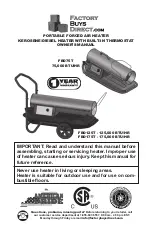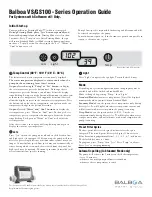
www.factorybuysdirect.com
7
160942-01A
Ground Wire (#10 AWG -
Stranded-Copper)
Copper
or Brass
Grounding
Point
Figure 4 - Typical Generator Grounding
Method (Generator construction may
vary from that shown)
PREVENTATIVE MAINTENANCE SCHEDULE
WARNING: Never service heater while it is plugged in, operating
or hot. Severe burns and electrical shock can occur.
OPERATION WITH PORTABLE GENERATOR
Alternator
Ground Lug
WARNING: Before operating
heater or any appliance from a
portable generator, verify that
generator has been properly con-
nected to earth ground. Improper
grounding or failure to ground
generator can result in electro-
cution if a ground fault occurs.
Refer to owner’s manual supplied
by generator manufacturer for
proper grounding procedures.
Operating voltage range of heater is 95 to 135
Volts. Prior to plugging heater into generator
output voltage should be verified (if generator
is equipped with automatic idle feature, output
voltage should be measured with generator
running at full speed). If voltage does not
STORING, TRANSPORTING OR SHIPPING
3. Properly dispose of old and dirty fuel.
Check with local automotive service sta-
tions that recycle oil.
4. If storing, store heater in dry place. Make
sure storage place is free of dust and
corrosive fumes.
IMPORTANT:
Do not store kerosene over
summer months for use during next heating
season. Using old fuel could damage heater.
measure in this range heater should not be
plugged into generator.
Refer to
Operation,
page 6, for starting, stop-
ping and resetting heater procedures.
Note: If shipping, transport companies require
fuel tanks to be empty.
1. Remove excess fuel from tank using a si-
phon pump. Drain remaining fuel through
filler neck by tipping heater to the rear.
2. If any debris is noted in old fuel, add 1 or 2
quarts of clean kerosene to tank, stir and
drain again. This will prevent excess debris
from clogging filters during future use.
Item
How Often
How To
Fuel tank
Clean every season or as needed.
See
Storing, Transporting, or
Shipping
, above.
Air output and
lint filters
Replace every 500 hours of operation or
once a year.
See
Air Output, Air Intake and
Lint Filters
, page 10.
Air intake filter
Wash and dry with soap and water every 500
hours of operation or as needed.
See
Air Output, Air Intake and
Lint Filters
, page 10.
Fuel filter
Clean twice a heating season or as needed. See
Fuel Filter
, page 11.
Fan blades
Clean every season or as needed.
See
Fan
, page 10.
Motor
Not required/permanently lubricated.








































